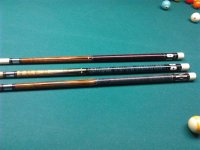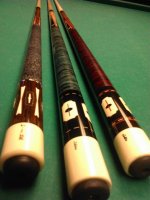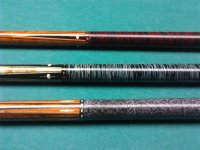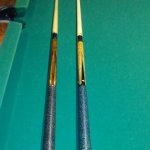Hi all , how can you tell the difference in short splice and full splice cues/ and which is more desirable > thanks
You are using an out of date browser. It may not display this or other websites correctly.
You should upgrade or use an alternative browser.
You should upgrade or use an alternative browser.
short splice/ full splice
- Thread starter I'mdoingit
- Start date
a short splice also known as a half splice is where single pieces of wood are placed into v-grooves in a forearm and turned down. This will make a forearm with points. A full splice is where the handle and the points are made out of a single piece of wood and slid over the v-grooves that are cut into a forearm and turned down. This produces a full length butt of a cue.
Last edited:
short/long
Thank you Mr Baker
Thank you Mr Baker
And as far as telling which is which in a completed cue, that is becoming much more difficult.
Sometimes, the maple (or whatever wood) of the forearm terminates to a sharp point above the wrap of the cue. This generally indicates a full-splice construction; however more cue makers are getting clever with their forearm groove cutting techniques and can achieve this appearance of a full-splice when in fact it is not a full splice. (I think DZ cues web site illustrates this well)
Also, some full-splice cues have the wrap pushed up to cover the base of the points, and it may in fact be a full splice construction, but you just can't tell unless the wrap is removed. (Tascarella does this and uses both full and half splice methods)
Still others are full splices (i.e. Titlist conversions) and the cue is cut below the points and a handle installed to lengthen the cue as is often needed due to these cues having a shorter length when new. So again, it started as a true full splice, technically it is a full splice construction (for the blank at least), but plays (and actually is now) a half-splice due to the handle joint, although this is a gray area, since the 'splice' is full and it is sectioned below the complete splice... But it does not play the same because the wood is interrupted between the splice and where you grip the cue (which interrupts the energy transfer), which for me is the significance of a full splice, not just appearance.
Also, ring work above the wrap generally indicates the cue has been cut (in order to install the rings) although there is one caveat to this- one (possibly more now) cue maker is doing inlay in this area that looks like a ring, but does not require cutting the cue to install it.
If the cue has no wrap, it is usually pretty clear.
So, the short answer is this: it's not very easy to tell in a completed cue, although the majority of cues made from the mid sixties to the mid eighties are short splice cues (with very few exceptions in that time frame) and now-a-days there has been a true Renaissance in cue making where the full-splice has made a recovery! (which makes me a happy man).
Sometimes, the maple (or whatever wood) of the forearm terminates to a sharp point above the wrap of the cue. This generally indicates a full-splice construction; however more cue makers are getting clever with their forearm groove cutting techniques and can achieve this appearance of a full-splice when in fact it is not a full splice. (I think DZ cues web site illustrates this well)
Also, some full-splice cues have the wrap pushed up to cover the base of the points, and it may in fact be a full splice construction, but you just can't tell unless the wrap is removed. (Tascarella does this and uses both full and half splice methods)
Still others are full splices (i.e. Titlist conversions) and the cue is cut below the points and a handle installed to lengthen the cue as is often needed due to these cues having a shorter length when new. So again, it started as a true full splice, technically it is a full splice construction (for the blank at least), but plays (and actually is now) a half-splice due to the handle joint, although this is a gray area, since the 'splice' is full and it is sectioned below the complete splice... But it does not play the same because the wood is interrupted between the splice and where you grip the cue (which interrupts the energy transfer), which for me is the significance of a full splice, not just appearance.
Also, ring work above the wrap generally indicates the cue has been cut (in order to install the rings) although there is one caveat to this- one (possibly more now) cue maker is doing inlay in this area that looks like a ring, but does not require cutting the cue to install it.
If the cue has no wrap, it is usually pretty clear.
So, the short answer is this: it's not very easy to tell in a completed cue, although the majority of cues made from the mid sixties to the mid eighties are short splice cues (with very few exceptions in that time frame) and now-a-days there has been a true Renaissance in cue making where the full-splice has made a recovery! (which makes me a happy man).
Short splice:
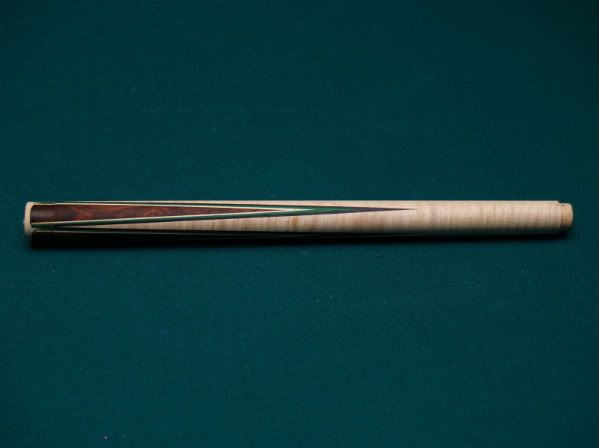

Full splice:
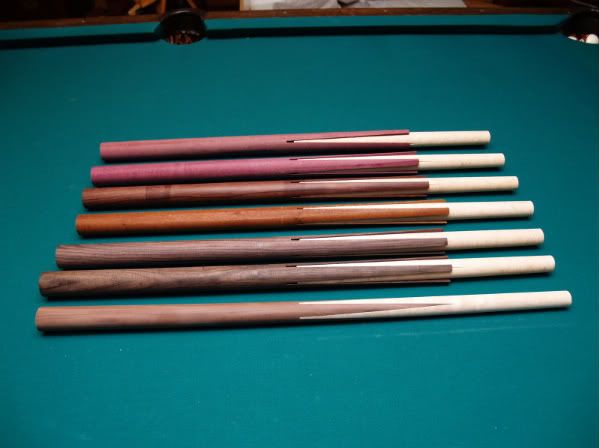



Full splice:


Last edited:
I am not sure which plays better,I am currently playing with a full splice cue,but I have also played short splice and I am not sure if either is better or why.
I tend to pick up a cue and shoot a few balls,if i like it I play it if I don't ,I sell it,but I have had them traded back and discovered I like what I didn't like before,sometimes the cue I liked started dogging balls for big money and I don't like that either, I can't play with a cue that practices good,plays cheap good,but dogs it when I jack the bet,and I have had several of those lately,which explains why I buy so many new cues.
I tend to pick up a cue and shoot a few balls,if i like it I play it if I don't ,I sell it,but I have had them traded back and discovered I like what I didn't like before,sometimes the cue I liked started dogging balls for big money and I don't like that either, I can't play with a cue that practices good,plays cheap good,but dogs it when I jack the bet,and I have had several of those lately,which explains why I buy so many new cues.
Hi all , how can you tell the difference in short splice and full splice cues/ and which is more desirable > thanks
Check out Hercek Cue.
MalibuMike
Banned
Early Schon Runde cues... Full Spliced or Short Spliced?
Are Early Schon Runde cues Full Spliced or Short Spliced?
Just curious because the folks at Tiger Products who did my wraps said the were full spliced, but some guy in a Schon Thread said Schon's are short Spliced. They said the Blue wrapped cue was full spliced, were they confused?
Are Early Schon Runde cues Full Spliced or Short Spliced?
Just curious because the folks at Tiger Products who did my wraps said the were full spliced, but some guy in a Schon Thread said Schon's are short Spliced. They said the Blue wrapped cue was full spliced, were they confused?
Attachments
They are short-spliced
They said the Blue wrapped cue was full spliced, were they confused?
Yes, they were confused.
MalibuMike
Banned
Thank you!!
Thanks!
Did Schon eve make full spliced cues?
Thanks!
Did Schon eve make full spliced cues?
To my mind, the bottom cue in MM's pictures is not even a splice, it's an inlay.
That does not say anything about whether it is a good or bad cue, might be exceptional.
But the cnc inlay method of making those points is not the same as either short or long traditional "splice"
smt
That does not say anything about whether it is a good or bad cue, might be exceptional.
But the cnc inlay method of making those points is not the same as either short or long traditional "splice"
smt
I'mdoingit - why do you ask? ..... all the pics so far of cues (with the exception of Murry's bottom pic) are all short splice.
The cue in my post is a full splice, you left it out.
The cue in my post is a full splice, you left it out.
Can you explain how the ring got between the forearm and handle?
Look back at the full splice cues in the making, how would you put a ring there?
Ring most likely has a .750" diameter on it's inside, please enlighten me, I am happy to listen.
Can you explain how the ring got between the forearm and handle?
Look back at the full splice cues in the making, how would you put a ring there?
Ring most likely has a .750" diameter on it's inside, please enlighten me, I am happy to listen.
Sure - $ cue, Davis blank
Attachments
Sure - $ cue, Davis blank
Looks like you've received too many greenies from me, it won't let me give you one on this. Funny thing, the wrap goes all the way to the ring in the first pic but the wrap channel does not on second picture. Thanks for the awesome response. I can see how some inlays may have been done, what about if it was a Brass ring with a .750" inside? Can't inlay something like that.
Last edited:
Looks like you've received too many greenies from me, it won't let me give you one on this. Funny thing, the wrap goes all the way to the ring in the first pic but the wrap channel does not on second picture. Thanks for the awesome response. I can see how some inlays may have been done, what about if it was a Brass ring with a .750" inside? Can't inlay something like that.
The guy that did the inlays for $ came up with the triple smart solution: inlay ebony squares over the veneers and inlay ivory squares in between the ebony inlays to give the appearance of a ring.
